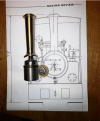OzzyO
Western Thunderer
Hello all,
setting up the "bearing block" for the cross slide. I'm quit happy at how its set up in the four jaw chuck to only get .015 (0.00059") over the length approx. 3.7"
Turning it was a bit bang bang until I got to the full face (it doesn't help that the head bearings are on the way out).


The next job is to drill the mounting holes, then to set it back up in the lathe and drill and bore the centre hole and the recess for the front thrust bearing.
An update on the cost.
Leadscrew £27.12 (this is for 1 meter I only wanted approx. 350mm).
Leadscrew nuts X3 £2.59.
Thrust bearings X 2 £2.35
Grease nipple (modification) £0.99
Total. £33.05
A lot better than my first estimate.
ATB
OzzyO.
setting up the "bearing block" for the cross slide. I'm quit happy at how its set up in the four jaw chuck to only get .015 (0.00059") over the length approx. 3.7"
Turning it was a bit bang bang until I got to the full face (it doesn't help that the head bearings are on the way out).


The next job is to drill the mounting holes, then to set it back up in the lathe and drill and bore the centre hole and the recess for the front thrust bearing.
An update on the cost.
Leadscrew £27.12 (this is for 1 meter I only wanted approx. 350mm).
Leadscrew nuts X3 £2.59.
Thrust bearings X 2 £2.35
Grease nipple (modification) £0.99
Total. £33.05
A lot better than my first estimate.
ATB
OzzyO.




































